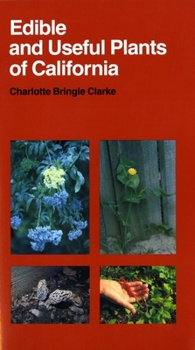Edible and Useful Plants of California: Volume 41
(Book #41 in the California Natural History Guides Series)
Select Format
Select Condition 
Book Overview
Both American Indians and the pioneers knew and used many different plant species-for food, fibers, medicine, tools, and other purposes. This unique book is a guide to identifying more than 220 such plants. But it goes much further-it also tells the reader how to prepare, cook, and otherwise use them. Some of the dishes for which recipes are given have won culinary prizes. All have been tested not only by the author but also by her students and by journalists-who have been uniformity surprised and impressed. The plants are organized by habitat communities. Description, photos, drawings, and distribution information are given. Where poisonous look-alikes exist, they too are illustrated. Much fascinating information about Indian uses of native and introduced species is included. The author emphasizes conservation considerations; the aim of the book is to educate the reader about intriguing uses of the plants, and to tell how to gather and use the most palatable and abundant species without damaging the environment.
Format:Paperback
Language:English
ISBN:0520032675
ISBN13:9780520032675
Release Date:February 1978
Publisher:University of California Press
Length:296 Pages
Weight:0.65 lbs.
Dimensions:0.8" x 4.8" x 8.0"
Customer Reviews
4 ratings
Informative info re edible wild plants
Published by Thriftbooks.com User , 16 years ago
Edible and Useful Plants of California (California Natural History Guides) If you are interested in wild plants, this is a good book for identification. The recipes provided are easy and delicious. I have already prepared Purslane (Verdolaga) in her recipe titled, "Verdolagas Con Queso" -- Excellent! There are many more I can't wait to try. Excellent book by Charlotte Bringle Clarke.
Enjoyable and useful guide
Published by Thriftbooks.com User , 17 years ago
As a former graduate student in botany I have almost 100 books on botany and plant identification, and this is one of the most fun and easiest to use guides that I have. It's not a rigorous guide, but it's not meant to be, since it focuses on the edible and useful plants of California. About a hundred species are covered, if I remember right (cut me some slack here since it's been awhile since I picked it up), and the notes on their herbal or culinary use, which I don't know as much about, increased my knowledge there. This would probably be one of the best books for an amateur to get their feet wet identifying plants because it limits itself to one topic and many of the easier species to identify. Plus you'll learn about how various plants they have been used in the past and continue to be useful today. For example, to mention just one, ceanothus, of which there are about 40 species in California, was used both as a tea substitute and tobacco substitute by the early settlers. And it's easily identifiable by the three prominent veins on the underside of the leaf, as well as the small, pretty clusters of violet flowers. Most of the 40 odd species are low growing herbs or bushes, but the largest species can be a 40 foot tall tree. Overall, a fine book and one that imparts a lot of fun, useful information.
dining in the wild
Published by Thriftbooks.com User , 18 years ago
Clearly written guide to edible plants with recipes and well told descriptions. I enjoyed every page.
Truely a useful plant identifiction book
Published by Thriftbooks.com User , 24 years ago
I have quite a few "nature" books on my shelf, and at least 5 on plant identification. I was a tad bit leary when I ordered this book, thinking that it would just become another dust gatherer. Boy was I wrong. It is one of the easiest reads I have ever seen on this subject. You do not have to have a degree in botany to get into, and begin to use the info in this book. It has rekindled my desire to learn more about the plant-life around me. If you live, and play outdoors in California, then I would definately recomend this book, and some of the recipes listed in this book really are to die for ( and I am not talking about the chapter on poisonous plant identification ).






